Can You Pump Car Tire with a Bike Pump? Exploring Your Inflation Options-
Introduction
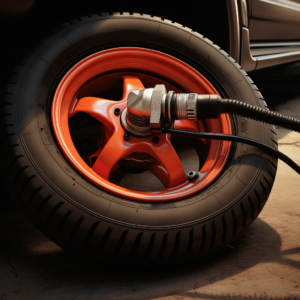
Imagine cruising down the highway on a sunny day, wind in your hair, and tunes on the radio. Suddenly, you notice that one of your car tires looks a bit deflated. Your heart skips a beat as you realize you don’t have an air compressor handy. But you do have a trusty bike pump in your trunk. Could this two-wheeled wonder be the answer to your tire troubles? In this comprehensive article, we embark on a deep dive into the intriguing realm of tire inflation. Let us uncover the possibilities, practicality, and safety concerns of using a bike pump to inflate a car tire. So, let’s journey together and unravel the mysteries of this inflation enigma!
Can you pump car tire with a bike pump?-The Art and Science of Inflation
Before we unravel the specifics, let’s get acquainted with the science behind tire inflation. The fundamental concept remains unchanged: air pressure is introduced into the tire to achieve the desired inflation level. Proper tire inflation isn’t just about maintaining aesthetics. It plays a pivotal role in optimizing fuel efficiency, extending tire longevity, and ensuring a secure driving experience.
Demystifying Bike Pumps
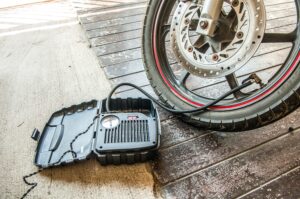
At the heart of our exploration lies the humble bike pump – a compact, lightweight device designed to inflate bicycle tires with utmost efficiency. These ingenious contraptions employ a piston or barrel mechanism to draw in and compress air. It is then pumped into the tire valve, subsequently boosting the air pressure within. Broadly categorized into floor pumps (or track pumps) and handheld pumps (or mini pumps), each type serves a distinct purpose. Floor pumps, larger in size, deliver higher air volume per stroke. Handheld pumps, although more portable, might demand additional exertion to reach the desired pressure.
Car Tires vs. Bicycle Tires: The Great Inflation Divide

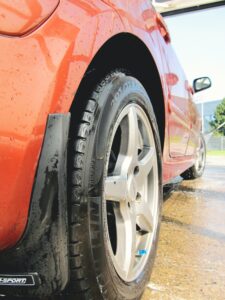
Though car tires and bicycle tires might appear akin, substantial differences lie beneath the surface. It dictates the viability of utilizing a bike pump for car tire inflation.
The Air Conundrum: Car tires command significantly greater air volume compared to their slender bicycle counterparts. Ergo, inflating a car tire using a bike pump involves an arduous endeavour that demands both time and sweat.
Pressure Predicament: Car tires demand a higher air pressure threshold than bicycle tires. Achieving the required pressure with a bike pump could prove to be a daunting task, particularly if dealing with handheld pumps.
Valve Varieties: Car tires predominantly embrace Schrader valves, whereas select high-performance bicycles flaunt Presta valves. Since bike pumps are engineered for specific valve types, an adapter might be requisite to bridge the gap for car tire inflation.
Size Matters: In the grand scheme of things, car tires tower over bicycle tires, thereby amplifying the challenge of inflating them using a bike pump.
Pump car tire with a bike pump- Bike Pump and Car Tire Marriage
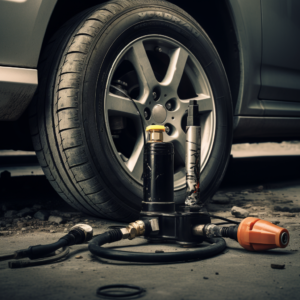
Can one realistically pump a car tire using a bike pump? The answer, in essence, is affirmative – yet, the process isn’t as straightforward as it may seem. Allow us to navigate the terrain of possibilities, limitations, and potential solutions.
Exertion and Time Investment: As previously mentioned, the mammoth air volume and pressure requisites of car tires translate to a demanding endeavor when using a bike pump. Brace yourself for a mini workout session!
Precision Predicament: Optimal tire inflation demands precision. Regrettably, the pressure gauges on most bike pumps may not be calibrated for car tire inflation. This may lead to over-inflation or under-inflation, both of which can cast a shadow on your driving experience.
Adapter Adventures: The car tire’s Schrader valve, broader than the Presta valves adorning bicycle tires, might necessitate an adapter to establish a connection with the pump. This introduces another layer of complexity to the inflation process.
Portability Paradox: While handheld pumps are portable allies, their air volume output might prove insufficient for efficient car tire inflation. In this regard, floor pumps, which boast higher air output, emerge as a more suitable option. However, their bulkiness might render them less travel friendly.
Emergency Emissary: In a dire scenario devoid of alternative options, employing a bike pump to infuse just enough air into a car tire to reach the nearest gas station could serve as a temporary measure. Nonetheless, it remains far from a sustainable solution, and immediate tire attention should be a top priority.
Pro Tips for Pumping Success
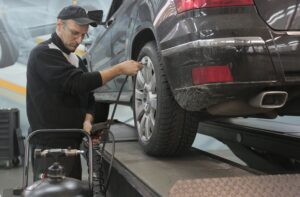
For those daring enough to tread the path of car tire inflation with a bike pump, here are a few pearls of wisdom to enhance your chances of success:
Gauge Guardian: Should the opportunity present itself, opt for a bike pump equipped with a reliable pressure gauge offering accurate readings. This ensures you stay in control of the pressure levels and can make necessary adjustments.
Adapter Amicability: Verify the compatibility of your pump and the car tire valve by procuring the appropriate adapter. A quick valve type assessment and consultation with your pump’s manual or manufacturer can circumvent potential pitfalls.
Endurance and Patience: Inflating a car tire with a bike pump necessitates patience and endurance. Brace yourself for a process that might test your stamina, and don’t hesitate to take short breaks if the need arises.
The Emergency Arsenal: Delve into the world of preparedness by stocking your car with a tire repair kit. Such a kit could encompass a temporary sealant for minor punctures and a portable air compressor for those unexpected emergencies.
Professional Parley: While the allure of the bike pump solution might beckon, a visit to a nearby gas station or repair facility at the earliest convenience should not be delayed. Seeking the aid of proper tire inflation equipment and expertise is a testament to responsible car ownership.
Final Takeaway-
In the intricate dance of tire maintenance, the bike pump emerges as a potential partner for car tire inflation. Yet, the complexities, labor-intensive nature, and accuracy challenges associated with this method render it less than ideal. In your pursuit of optimal tire health and driving safety, consider investing in a dependable air compressor or visiting tire inflation stations equipped with the appropriate tools.
Remember, while the notion of using a bike pump as a stopgap measure might be tempting, the well-being of your car’s tires should remain paramount. By embracing a pragmatic approach and ensuring timely tire care, you can embark on your driving adventures with confidence, knowing that your tires are in optimal shape to conquer the road ahead.
